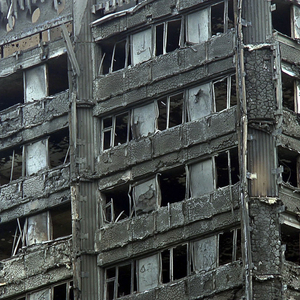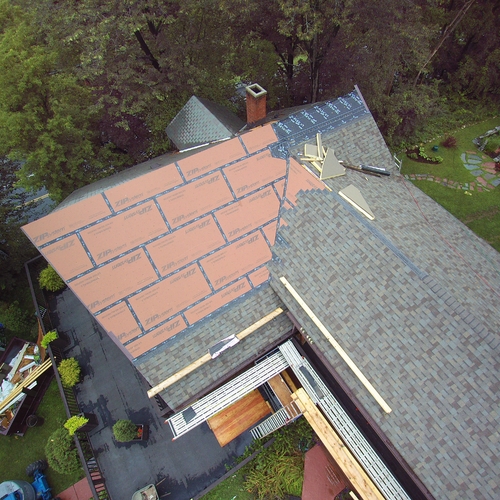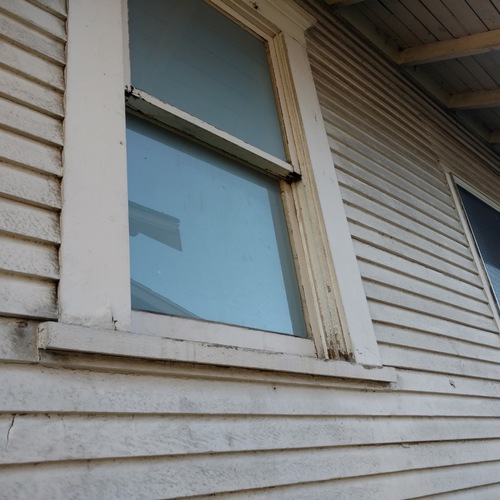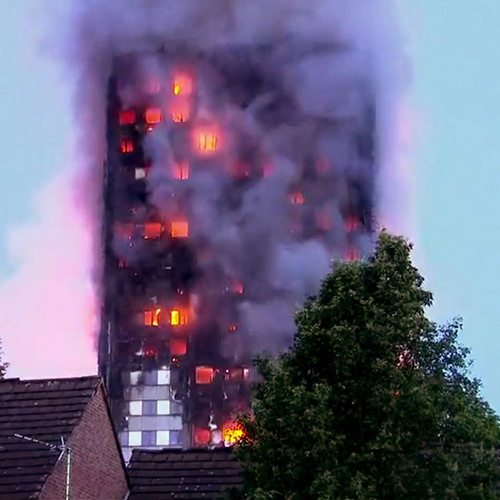Image Credit: Image #1: Mémoire2Cité / Flickr
Image Credit: Image #1: Mémoire2Cité / Flickr The exterior of Grenfell Tower after a fast-moving fire burned to the top of the 24-story building. (Photo: Catholic Church England & Wales / Flickr)
Image Credit: Image #2: Catholic Church England & Wales / Flickr This illustration of Reynobond cladding appears on the web site of Arconic, the manufacturer of Reynobond.
Image Credit: Image #3: Arconic
Investigators in London are studying whether an aluminum-faced cladding that contained rigid foam insulation contributed to the speed at which fire engulfed a 24-story apartment building on June 14, killing at least 79 people.
The fire at Grenfell Tower, a 24-story building in West London that contained 120 apartments, raced up the sides of the building with a speed that amazed firefighters. Attention soon turned to the role of aluminum-faced insulation panels in the fire’s rapid spread. The Reynobond PE cladding panels were added to the building’s exterior during a renovation.
Reynobond consists of two sheets of aluminum, each 0.02 inches thick, with a core of extruded polyethylene insulation in between. (In the U.S., extruded polyethylene is more often used for pipe insulation or for cushioning delicate equipment in packing cases than for building insulation.)
This type of panel isn’t typically found on residential projects. A growing number of residential builders in the U.S., however, attach rigid foam insulation directly to the exterior of wall or roof sheathing, and cover it with a vented rainscreen and siding. That’s a relatively common approach in high-performance buildings where designers are looking for ways to increase the overall R-value of the wall and minimize thermal bridging through wood framing.
The fire in London with its horrific loss of life may strengthen arguments from foam opponents here, but it should not dissuade builders from continuing to use rigid foam in wall assemblies, one Massachusetts architect says, because the energy-efficiency advantages of foam outweigh its risks.
Details at Grenfell Tower
It may take many months before investigators in London are able to pinpoint the cause of the fire, and whether the cladding played a significant role in how quickly it spread. The tower, with 20 floors of apartments, was originally built in 1974. It underwent a renovation, completed in 2016, which included the installation of the Reynobond PE panels.
The Guardian reports that the wall assembly included Reynobond PE and a layer of Celotex RS5000 polyisocyanurate insulation behind it, the two separated by an air gap. Celotex manufacturer Saint-Gobain says that the insulation was “developed specifically to enhance the thermal performance of external facade constructions.” The foil-faced polyisocyanurate has a “Class O” fire performance rating, a category used for hospitals, schools and retirements homes.
The £10 million renovation involved a number of companies and subcontractors, including Harley Curtain Wall/Facades, which won the £2.6 million contract to install new cladding. The Guardian reported that Harley used products from both Celotex and Arconic, which manufactured Reynobond. Contractors saved about £2 per square meter by installing Reynobond PE instead of a more fire-resistant cladding panel called Reynobond FR, the newspaper said. The FR version has a mineral core that resists fire.
Residential use of foam is different
Will the fire give builders who use exterior rigid foam a reason to change their minds? Possibly. But
Steven Baczek, an architect in the Boston area who has designed a number of high-performance houses, says that rigid foam insulation is probably here to stay because of its many energy-efficiency advantages. The way foam is typically used in residential building — installed on the exterior side of structural sheathing — reduces the risk of injury and death in a fire because the sheathing offers an ignition barrier that should give occupants time to get out of the house.
“If I put up a Zip [System] wall and then put polyiso on the outside, I effectively have the rigid foam outside of at least a 30-minute, maybe one-hour, assembly,” he said in a call. “So what am I worried about there? … Would it go up quick? Probably, but it’s on the outside of the house.”
Spray foam used on an attic interior must be covered by a 15-minute ignition barrier, he added, “so the plywood in the wall is doing you at least double what the code requires you to do in the attic.”
If occupants couldn’t get out of a burning house in that time frame, he said, it probably means there’s something wrong with fire alarms inside the house.
“It’s certainly a tragedy,” he said of the London fire. “You don’t want any house to burn down. You don’t want any life to be lost. But foam provides comfort and energy efficiency over a very long time. You don’t want to say it’s worth a life. It isn’t. But the reality is the benefits seem to outweigh the risks.”
Are rainscreens a bigger risk?
Bazcek is more cautious about rainscreens, which are built-in gaps between the back of the siding and the insulation or sheathing that permit siding to dry faster and accumulated moisture to escape more readily. Ventilated rainscreens are becoming more common, but Bazcek likened them to
a “chimney every 16 inches on-center around the house.”
In the case of Grenfell Tower, an unbroken air gap would amount to a chimney more than 200 feet tall. It’s not clear whether fire breaks had been included in Grenfell’s walls to slow or stop the movement of fire from one floor to the next. But even in residential construction, with a rainscreen of only one or two stories, flame spread is enough of a concern in some jurisdictions that inspectors require it to end at the top of the wall — without connecting to the attic or roof ventilation, Bazcek said.
That said, he prefers to tie the two together because it’s more effective at removing moisture.
“You elongate the stack effect by connecting the wall to the roof ventilation system, and if you elongate the stack effect you increase the effectiveness,” he said. “It’s nice when it’s connected, but some jurisdictions don’t allow you to do it.”
Bazcek plans to continue using both rigid foam and vented rainscreens in the walls he designs, believing the advantages outweigh the risks. He also points to an inherent risk in all wood-framed buildings, whether they use rigid foam and a rainscreen or not: wood in old houses is very dry and very combustible.
Weekly Newsletter
Get building science and energy efficiency advice, plus special offers, in your inbox.
















12 Comments
Well, when the fire eats the
Well, when the fire eats the rigid foam insulation and races up to the roof, if you are in a one story house you can probably just jump out the window and live (assuming it's the other side that's on fire). If this is a high rise, you'd be dead.
If this is a second story house, as long as you don't jump into the ground head first, you'd probably would live too.
Insurance should increase the rates for insuring a house with rigid foam though, so the rest of us don't pay to subsidize the fire.
Exterior Foam
While I appreciate Steve Baczak's reasoning, I'm not sure I share it.
Our code precludes tying a rain-screen to the attic for the same reason codes generally require fire-stops at the top of any concealed space (like chases or bulkheads). Connecting the differing assemblies allows fire to spread undetected and unimpeded from one to another. Surely not a good idea.
It's also not clear there is a significant advantage of a tied system over one that is simply vented at the top, or for that matter one that is only open at the bottom. There is a real benefit to adding a rain-screen to a wall in most climates. Once this advantage has been realized, the additional performance gains from one type of rain-screen to another could be considered marginal.
Steve's claim that an exterior wall is already a "30 minute to one-hour assembly" may be true, but just as the fire ratings of ceilings are measured from the bottom to the top, exterior wall assemblies are measured from the inside to the out, relying heavily on the presence of gypsum board, so a fire in the exterior foam can broach a wall a lot more quickly than an interior fire could.
Arguing that a fire "on the outside of the house" makes it somehow safer is also belied by the situation tenants of the Grenfell Towers faced. Being surrounded by flames can be more dangerous that a fire within a house.
Finally, I don't think it helps the argument to claim that since foam is widely used and useful we should simply consider its use in this manner inevitable and part of the risks of living in a house. Surely that isn't how we should think about any of the components that go into our buildings?
Rainscreens
Local code states that inside of a home there must be "fireblocks" in the walls so that in case of a fire inside the wall cavitiy, it will be slowed down and not spread due to the blocks preventing it from climbing/jumping.
In fire country (southwest), rainscreens & attic vents are fire hazards. In wildfires the embers are the most dangerous element. Embers can and will enter into attics due to the attic gable and ridge vents. Once inside the attic the embers will ignite the roof trusses and the rest is history.
With rainscreens, the embers can also enter into the wall cavity (albeit a little harder due to rainscreens being low on the wall portion). Once the embers are inside the wall cavity, they can ignite the structure within the cavity area.
In residential and non-wildfire scenarios, rainscreens don't post much of a fire hazard but in a high-rise and/or southwest wildfire scenario, they do pose a fire risk.
Another reason to shift to renewable insulation
This article leaves me wondering why the GBA is defending non-renewable petrol products while its spends the rest of its time writing about how to get people off non-renewable fuel sources? The more I learn about foam insulation compared to other materials, the more its looks like one of those conflated products that has benefited for too long behind a lot of marketing money. Sure, its a good insulator, but its worth a catastrophic fire every once in a while? Sounds like something out of Washington.
Everyone has rallied around finding alternatives to oil and gas, but somehow foam is just too precious? Even though evidence slowly leaks out that there are many faults to foam, there is still resounding call that the advantages outweigh the "risks".
I would like to see a list of the advantages with good, supportive, third party documentation.
There are more and more renewable, insulation materials that are making their way to the market, which is still slow in a world of cheap, subsidized oil. With more support and development, there will soon be many insulation materials that will make foam obsolete before the last drop of oil is pumped up from below.
Lets start holding a better goal for insulation materials worthy of our buildings of a regenerative future.
Response to Ben Graham
Ben,
First of all, there is no "GBA position" on the Grenfell Tower fire. This is a news report -- one that happens to include an interview with an American residential architect. While I have no doubt that the quotes attributed to Steve Baczek are accurate, Baczek does not speak for GBA.
The causes of this terrible fire are still under investigation, but among the possible elements that contributed to the loss of life were the use of polyethylene cladding, the fact that the rainscreen gap may have lacked fire blocking, the use of polyisocyanurate insulation (mentioned less often than the polyethylene cladding, but a possible contributor nevertheless), the fact that the building had only one stairway, the lack of any fire sprinklers, and the lack of a central fire alarm system.
Based on the information presented so far, it certainly appears that mineral wool would be a much better choice for multi-story residential buildings than extruded polyethylene (rarely used in the U.S.) or polyiso. Whether polyiso is dangerous on one-story and two-story residential buildings is less clear, but I await the judgment of fire experts on the matter.
It wouldn't surprise me a bit if British authorities adopt more stringent fire tests for cladding materials on high-rise buildings. (Reportedly, the United States already has more stringent requirements than Britain in this regard.) Moreover, it wouldn't surprise me a bit if British architects turn away from rigid foam products for multi-story buildings, in favor of mineral wool insulation. If I lived in a high-rise building with exterior insulation, I would certainly sleep better at night if I knew that the exterior insulation was mineral wool than if I knew that the insulation was some type of rigid foam.
Mineral wool is a wonderful product. I don't think it's "renewable," but it's a type of insulation that is less flammable than polyiso or extruded polyethylene.
Questions and Details
I have been trying to understand some of the details of this story. These are some of the points that I have gleaned so far, along with some questions they raise:
In the wall cross section, there was the exterior cladding composed of a polyethylene core with an aluminum skin bonded to each side of the core. Was that polyethylene core composed of polyethylene foam or solid? It is often referred to as “extruded”, and some plastics are extruded as foam, but I do not believe that the term means it has to be foam. How thick was the cladding? I have the impression it was something less than 3/8”.
Moving inward from the cladding, there was an air space gap of 1-2”. Then moving inward from the gap, was polyisocyanurate foam insulation presenting its open (un-faced) surface to the air space gap.
Has it been determined how a fired was ignited in this wall? Though flammable it was, I cannot imagine a scenario of ignition other than somebody burning leaves near the base of the building.
In any case, ignition first occurred in either the polyethylene core of the cladding or in the polyisocyanurate insulation. Then, once ignition occurred, both materials fueled the fire as it spread upward through the air space gap. Apparently the inner aluminum skin of the cladding simply vaporized with the heat of the fire and then presented the polyethylene core material as fuel for the fire.
All of this (except for the cause of ignition) is entirely understandable and predictable. What is completely unfathomable, however, is why the regulators allowed such a fire hazard to be built.
How could a bureaucracy full of fire safety experts, scientists, engineers, and regulators have missed it? That does not seem plausible to me. So what is the full story behind the decision to use this deadly cladding detail?
Response to Ron Keagle
Ron,
Stay tuned. Reports and indictments are coming.
Ron
The ignition point was a defective refrigerator. The fire spread from a suite to the cladding via a window, scaled the building entering suites along the way.
Thanks for that information
Thanks for that information Malcolm. I can see how that would have happened. Flames going out of a window would probably contact the cladding or get close enough to it to ignite it.
London Fire
Martin
You are an insightful and accomplished author. While not accountable for the comments of all your people posting, you should know better by now not to conflate and exacerbate issues and fuel reputation assassination of other products in an article like this just because they may have a commonly used term: foam. And the intermingling of commercial/high-rise and residential practices only confuse the reader and issue more. "Foams" have different chemistries, assemblies and burn characteristics, and spray polyurethane foam had nothing to do with this horrific incident. To the unsophisticated reader you raise the possibility that SPF could have easily been a culprit with your passive inclusion, and raise unsubstantiated concerns about "foam" use in residential buildings which are not the issue here, whether you put the generic word “rigid” in front of it or not.
“Will the fire give builders who use exterior rigid foam a reason to change their minds? Possibly.” The title of this section seems to suggest a reassurance that residential use of foam is different. While you do ask, and then answer your own question that builders may subsequent to this fire reconsider the use of "foam" in residential building practice, the only quote you offer in contrast is one that kind of suggests the EE is worth the risk to one human life, even though they contradict their own initial comments and say it isn’t. It just isn't and it isn’t part of anyone’s consideration that it should be. If the design, assembly and install is correct you get EE and safety and both are doable by knowledgeable people, and there is no “risk” to be accepted for the benefit of EE. They are not mutually exclusive as your use of the quote allows to be suggested, and the quote doesn’t educate on SPF, it just explores one person’s use of it which readers will know doesn’t apply to all situations so they are left wondering if they have risks if they aren’t working with Steve or doing what he is doing. I know what Steve was trying to say, but in the scope of your article it really didn’t come across appropriately. This section of your article turned out more to be a passive-aggressive disingenuous inclusion of “foam” in residential application, focused upon SPF which as mentioned had nothing to do with London, rather than the reassurance I hoped it would be, which is unfortunate.
People that hate "foam" because it isn't part of their wheelhouse or don't understand it can argue about this stuff all day, and they will to the point I wonder when they actually get real work done. But Joe's recent thorough explanation of the complex design and application failures of this project that actually led to the disaster deliver much more reliable information than preliminary news reports and speculation (although I concede you did get a good chunk of your speculation on the cladding correct).
https://buildingscience.com/documents/building-science-insights/bsi-098-great-fire-london?utm_source=Building+Science+Corporation+List&utm_campaign=783cb03af6-BSC+Newsletter+Issue+%2399&utm_medium=email&utm_term=0_194890bc8c-783cb03af6-63935289
I hope your readers find his article informative.
Response to Kurt Riesenberg
Kurt,
While your comments are addressed to me, I was not the author of the piece on this page. Credit for this article goes to Scott Gibson, our news editor.
While it's true that (as senior editor of Green Building Advisor) I have responsibility for the stories posted on our site, it's also true that GBA is a forum for many different voices, not all of which are congruent.
My own statement on this story was stated in Comment #5 on this page: “There is no ‘GBA position’ on the Grenfell Tower fire.”
To read another perspective on the Grenfell Tower fire -- one by contributor Brian Meacham -- see Could a Grenfell Tower Fire Happen Here?
Tower Fire
Hi Martin
You are very right! I stand corrected and offer apologies for the incorrect attribution. It does in fact say Mr. Gibson and I missed it...a hack move on my part. Like I said I always appreciate your writing and as noted was surprised that it would have come from you.
I will appropriately redirect my comments to Mr. Gibson then. And will look forward our future interactions. Thank you for the clarification.
Best!
Kurt
Log in or create an account to post a comment.
Sign up Log in